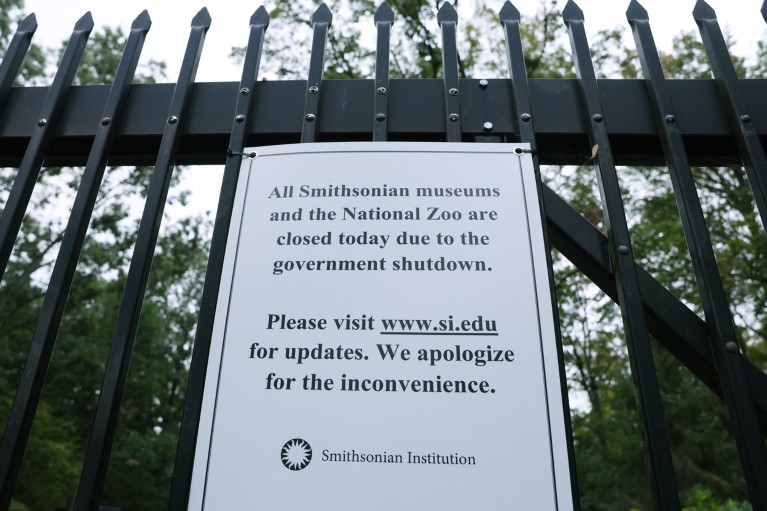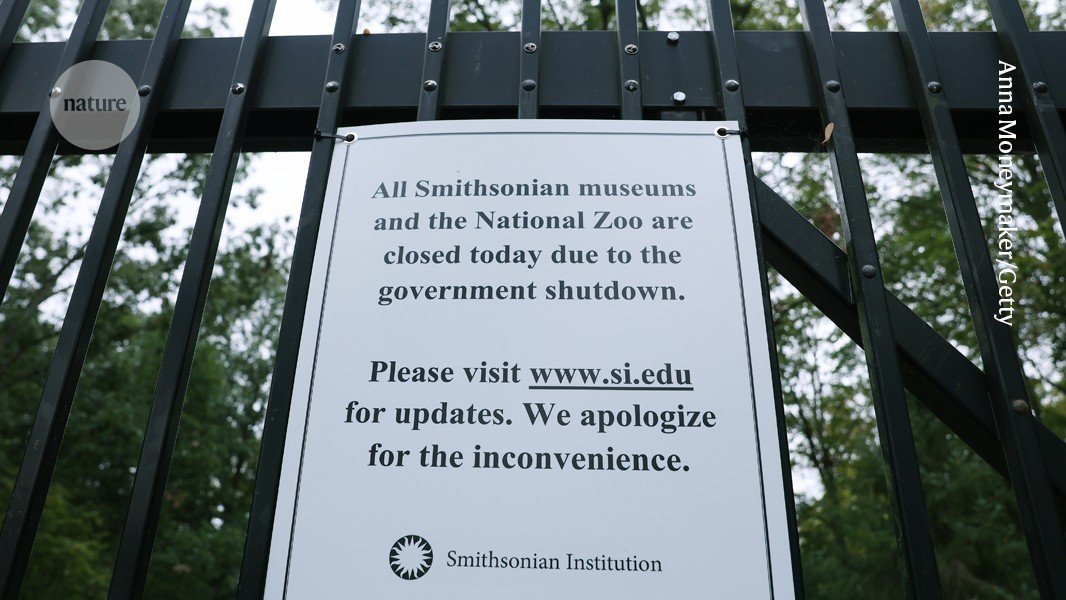
The closure of the US government has shuttered the Smithsonian Institution’s museums and zoo and some of its research facilities. Credit: Anna Moneymaker/Getty
The shutdown of the US government, about to enter its third week, is starting to take a toll on US science. Since the shutdown began, the administration of US President Donald Trump has cancelled funding for clean-energy research projects and laid off public-health workers. The activities of some federally funded museums and laboratories have been suspended, along with the processing of grant applications by agencies such as the National Science Foundation (NSF).
Funding to run the US government expired on 1 October after members of the US Congress failed to pass a spending bill. Negotiations to end the impasse have made little progress. Lawmakers from the opposition Democratic party say that they will only pass the spending bill if it extends popular health-care subsidies, a condition that Republicans do not want to negotiate. “The longer this goes on, the deeper the cuts are going to be,” Vice President JD Vance said Sunday.
Staff reductions
The Trump administration said in a court filing Friday that it will lay off 4,100- 4,200 federal employees, an action officially termed a reduction in force (RIF). The Trump administration invoked the absence of a spending bill as justification for the layoffs, which are an unprecedented measure during a shutdown. Unions representing federal workers have filed suit over the layoffs.
Trump team guts AIDS-eradication programme and slashes HIV research grants
Starting Friday night, some 1,300 staff members of the US Centers for Disease Control and Prevention (CDC) received RIF notices, although the notices for 700 were quickly rescinded, according to Local 2883 of the American Federation of Government Employees, a union representing CDC employees. The layoffs would “undermine the nation’s ability to respond to public health emergencies,” a CDC staff member affected by the layoff said Tuesday at a news conference organized by Local 2883.
Word of layoffs at the CDC’s influential National Health and Nutrition Examination Survey (NHANES) sparked particular concern among epidemiologists. The programme has been collecting US health data since the early 1960s, and has helped researchers to understand critical public-health issues such as the health effects of lead in petrol.
Former CDC staff member Asher Rosinger, an epidemiologist at Pennsylvania State University in University Park, says CDC staffers told him that the layoffs have decimated the NHANES planning branch, a team he says is critical to the operation of the programme. “This gold standard survey may no longer be able to operate in the future,” he says.
Double layoff
Some CDC employees have now been laid off twice in the span of half a year, says mathematical statistician Isaac Michael. At the CDC, Michael and his colleagues ran a survey and database that track the experience of new mothers in the United States — until the entire team was laid off in April. Several court orders have preserved their employment status for now, though they are still not allowed to work even when the government reopens. But some of his colleagues received a second layoff notice within the last few days, making it unlikely they will ever be reinstated.
Trump links autism and Tylenol: is there any truth to it?
If a state experiences a future uptick in maternal or infant deaths, “we won’t even know there’s a problem, because we’re not collecting any reliable data, and we won’t be able to do anything to help”, Michael says.
Andrew Nixon, communications director at the US Department of Health and Human Services (HHS), which oversees the CDC, said that all HHS employees receiving reduction-in-force notices were designated as non-essential by their respective divisions, and that the department will continue to close “wasteful and duplicative entities”.
The administration’s court filing said that the US Environmental Protection Agency would lose 20-30 people. Staff members at US Department of Energy (DoE) offices overseeing renewable energy, energy efficiency and other areas have also received RIF notcies, a DoE spokesperson said. “These offices are being realigned to reflect the Trump administration’s commitment to advancing affordable, reliable, and secure energy for the American people,” the spokesperson said.
Funding cuts
Coinciding with the shutdown, the administration has also announced a fresh round of cuts to research projects, adding to billions of dollars in federal research grants revoked since Trump took office in January.
On the second day of the shutdown, the DoE announced that it was cutting almost US$7.6 billion in funding from 223 energy projects, many of them supporting renewable energy. An analysis by Nature found that the list includes grants to 33 academic institutions, which have a combined value of $620 million.
Five key climate and space projects on Trump’s chopping block








